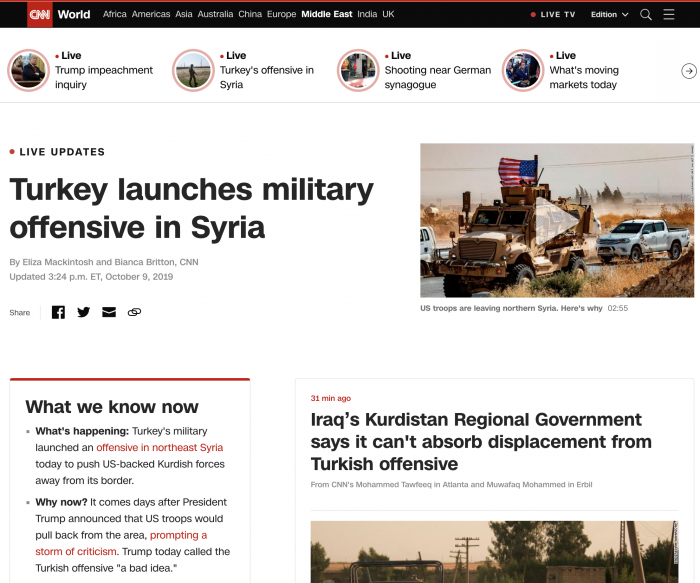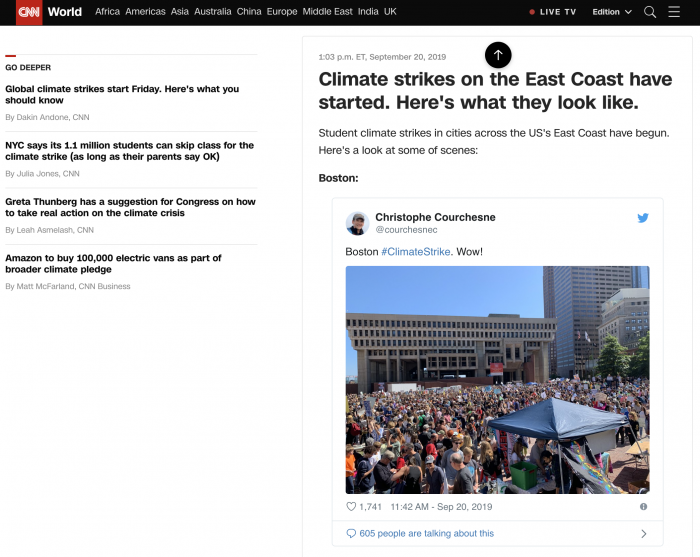
What do you do when the breaking news is coming in from all over, all the time?
Some people stop using their news apps (or don’t even download them in the first place) out of sheer overwhelmingness. And some people turn to CNN for live updates.
On Wednesday, for example, you could find live updates on market factors, a shooting near a German synagogue, Turkey’s military moves in Syria, and oh yeah, the Trump impeachment inquiry on CNN’s site in what’s essentially a live blog format.
Politico, The New York Times, and plenty of others publish liveblogs for elections and other major events, so this isn’t breaking news in itself, but CNN’s live story is a new tool spun up by the product team in the past year with pretty decent results so far. The tool had its highest traffic in August covering the El Paso and Dayton shootings and Hurricane Dorian, with 35 million unique visitors from CNN Digital. (Dorian’s live story, updated for nine consecutive days, had 29 million unique users.)The live story tool, known internally as the “dynamic live experience,” is basically a way to keep all the breaking news straight, more quickly. But the team had to build a brand-new CMS to make it happen.
“It’s acknowledgement that the story is ongoing, with built-in notifications,” chief technology officer Robyn Peterson said. He led the five to ten product folks working on the continual development of the tool, which can now support video and live results from election polling. “It was such a different form of content, such a different platform, that it really deserved to be built by itself.”
“We needed a product to push out news faster to a consumer, even if it’s just one to two sentence updates,” director of breaking news for CNN Digital Amanda Wills said. “When people think of CNN as a brand, they very much think of the pace and breathlessness they see on air. I wanted us to mirror that.”
Live stories are promoted at the top of the website, similar to the blinking “LIVE TV” that you might see. In addition to the auto-uploading updates, a sidebar on the left explain variations of “Where things stand now” or “What we covered here,” depending on if it’s still live or not. Bullet points give a primer before a reader jumps into the scrolling fray, and a video autoplays at the top. After a few scrolls down the page you’ll see some links if you chose to explore the topic in more depth. On mobile, the sidebar shows up first.


These blogs supplant the process of updating regular articles, where a reporter would write the sentence or two of new information and add a few extra paragraphs of context. The context is now built into the blog, where editors can virtually read over the shoulders of the writers to save time on publishing. “When my team is working on something that is super urgent I am reading them as they are typing. When they’ve moved on to the next sentence” she starts editing the previous one, Wills said.
Each live story needs at least two people to maintain it — a reporter and editor — but some have had as many as 10 adding to and refining them, like during the CNN debate. Unsurprisingly, Wills does not see an operational limit to how many can be maintained simultaneously.
“How many updates are we getting on this story? How many reporters are on this story? How much are we getting, information-wise, on this story?” she said as examples of how to decide which event gets a live story. “We really don’t have a shutdown date for [impeachment] because it’s so ongoing. We might move URLs as the story changes but we are consistently live on that story. When it’s something like a storm or a hurricane, we tend to launch in the lead-up to that hurricane. When it’s out in the Caribbean and we know it’s going to make landfall in the next few hours, that’s when we’re going to launch. We keep it running until the hurricane has dissipated or until it’s made landfall and the impacts are felt and the storm is over. Then we shut down the ‘storm is coming’ live story and then we move into the next phase, which is recovery.”
Most of the viewership comes when those stories are live, but CNN is exploring a time capsule-like afterlife. After the Oscars ceremony, Wills’ team reframed the collection as “relive the Oscars as it happened.”